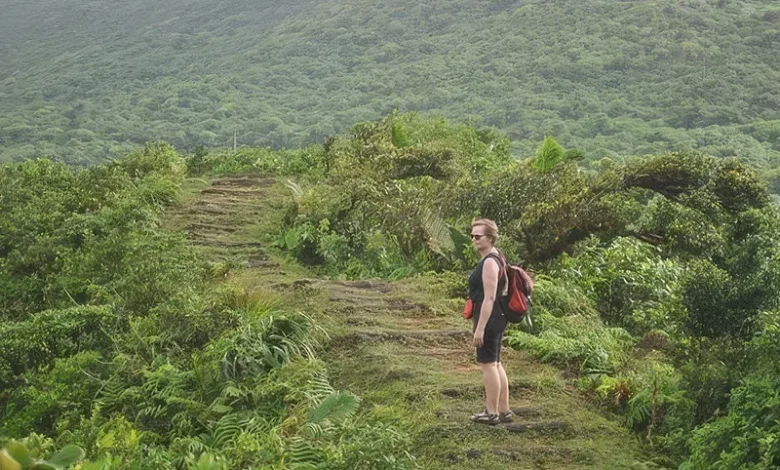Morne Trois Pitons National Park

Castle ComfortMorne Trois Pitons National Park is Dominica’s most iconic natural treasure, named after the towering volcanic mountain that defines its interior. Recognised as a UNESCO World Heritage Site since 1997, the park spans over 6,857 hectares, preserving nearly 9% of the island’s total landmass. It serves as a living, breathing museum of volcanic activity, rich biodiversity, cultural heritage, and untamed adventure—making it one of the most ecologically significant zones in the entire Caribbean.
A Geological Heartbeat of the Island
This protected area is anchored by Morne Trois Pitons, a dormant volcano rising to 1,342 meters (4,402 feet). The mountain’s name, which means “Mountain of Three Peaks” in French, reflects the island’s colonial past and topographical drama. It is part of a mountainous spine that includes other volcanic giants like Morne Watt, Morne Micotrin, and Morne Anglais. These massifs shape the island’s rugged landscape and feed its network of rivers, lakes, valleys, and hot springs.
One of the most renowned geological features within the park is the Boiling Lake—a flooded fumarole and the second-largest of its kind in the world. Often shrouded in thick steam, the lake can reach temperatures of 92°C (197°F) along its edges. Accessing it requires a challenging, full-day hike through the Valley of Desolation, where sulphur vents, bubbling mud, and strange mineral formations create a landscape that feels almost alien.
Other geothermal features include:
- Sulphur Springs at Wotten Waven
- Waterfalls like the one at Titou Gorge
- Numerous steam vents and warm river pools scattered throughout the park’s interior
Biodiversity: A Sanctuary of Life
Morne Trois Pitons National Park supports an extraordinary variety of flora and fauna, much of which are endemic species, native to the island or the Eastern Caribbean. The park includes at least five types of tropical forest ecosystems, ranging from lowland rainforest to montane elfin woodland.
Notable plant species include:
- Gommier trees (Dacryodes excelsa)
- Tree ferns
- Bamboo groves
- Epiphytes, mosses, and orchids in higher altitudes
The fauna is equally remarkable. Dominica is home to 176 species of birds, many of which can be found within the park boundaries. The most symbolic is the Sisserou Parrot (Amazona imperialis), Dominica’s national bird and one of the rarest parrots on Earth. Its cousin, the Jaco Parrot (Amazona arausiaca), is also found here and are endangered species. Other key wildlife includes:
- Agouti, a shy forest-dwelling rodent
- The Hispaniolan tree frog
- Anoles, snakes, and butterflies
- Fruit bats roosting in volcanic caves
The park is designated an Important Bird Area (IBA) by BirdLife International and serves as a living laboratory for conservation research and biodiversity monitoring.
Waterfalls, Lakes, and Pools
Water plays a defining role in the park’s ecosystem. With Dominica having the most rivers per square mile in the Caribbean, many of them originate in this park.
Notable Waterfalls:
- Trafalgar Falls – Two towering waterfalls called “Mother” and “Father”, offering swimming and hot spring pools nearby
- Middleham Falls – A 200-foot cascade that plunges into a basin, reached via the moderate Middleham Falls Trail.
- Emerald Pool – A scenic, easily accessible waterfall with a pool that glows green in sunlight, popular among cruise visitors
Lakes and River Systems:
- Freshwater Lake – Dominica’s largest lake, ideal for kayaking and picnicking, surrounded by misty forest
- Boeri Lake – A high-altitude crater lake, accessible by a moderate Boeri Lake Trail from Freshwater Lake
- Dozens of streams, rivulets, and springs that flow down steep valleys into Dominica’s central and eastern river systems
These freshwater features don’t just attract visitors—they support an entire range of aquatic and semi-aquatic species and serve as vital water sources for the island’s communities.
Adventure Tourism and Trails
Morne Trois Pitons National Park is a premier destination for eco-tourism and adventure travel in the Caribbean. It offers some of the best hiking and nature experiences in the region, with trails maintained by the Forestry, Wildlife and Parks Division and supported by local guides and eco-lodges.
Major Trails in the Park:
- Boiling Lake Trail – A strenuous 6–8 hour trek that passes through rainforest, river crossings, the Valley of Desolation, and ends at the Boiling Lake
- Freshwater Lake to Boeri Lake Trail – Ideal for birdwatching and cooler climate hikes, taking 2–3 hours round-trip
- Middleham Falls Trail – A moderate 45-minute hike through rainforest to one of the island’s tallest waterfalls
- Emerald Pool Trail – A short, 15-minute loop with interpretive signage and easy access for visitors of all ages
The park is also connected to segments of the Waitukubuli National Trail (WNT), particularly Segment #4 and Segment #5, linking it to Wotten Waven, Laudat, and Castle Comfort—villages known for hot springs and local hospitality.
Community Involvement and Conservation
The management of the park is overseen by the Forestry, Wildlife and Parks Division under the Ministry of Environment. Conservation initiatives are also supported by:
- The Nature Conservancy
- UNDP GEF Small Grants Program
- BirdLife International
- Local village councils and eco-groups
Education programs, youth outreach, and sustainable farming initiatives are embedded into the park’s conservation efforts. Many residents from nearby communities such as Laudat, Wotten Waven, Morne Prosper, and Giraudel work as guides, rangers, and ecotourism operators.
Visitor Impact and Sustainable Tourism
Morne Trois Pitons National Park plays a vital role in Dominica’s economy. It supports:
- Tour operators and guides
- Eco-lodges and guesthouses
- Artisan producers of crafts and herbal products
- Adventure companies offering canyoning, birdwatching, and volcano tours
To reduce pressure on popular areas like Boiling Lake, the Forestry Division encourages regulated visitor flows, permit systems, and partnerships with certified guides. Recent efforts include trail restoration projects, improved signage, and waste-reduction campaigns targeting visitor hotspots.
Helpful Visitor Tips
Here are a few key suggestions for those planning to visit:
What to Pack:
- Sturdy hiking boots or trail shoes
- Lightweight rain jacket and quick-dry clothes
- Reusable water bottle
- Camera or binoculars for birdwatching
- Sunscreen and insect repellent
Best Time to Visit:
- December to April (dry season), though expect occasional rain year-round
- Mornings offer clearer views, especially for summit hikes and Boiling Lake
Hire a Local Guide:
- Guides are highly knowledgeable, trained in safety, and are excellent storytellers of the island’s history and biodiversity
- Many belong to associations such as the Waitukubuli National Trail Tour Guides Association
A Park Like No Other
In Morne Trois Pitons National Park, Dominica breathes. Volcanic peaks disappear into clouds, vibrant parrots pierce the rainforest hush, and rivers carve deep into the earth. It’s a place of energy and emotion—where nature demands your attention and rewards it with wonder.
For hikers, researchers, nature lovers, and cultural explorers, the park offers an immersive encounter with one of the Caribbean’s most extraordinary landscapes—one that continues to shape the identity, ecology, and future of the island.




